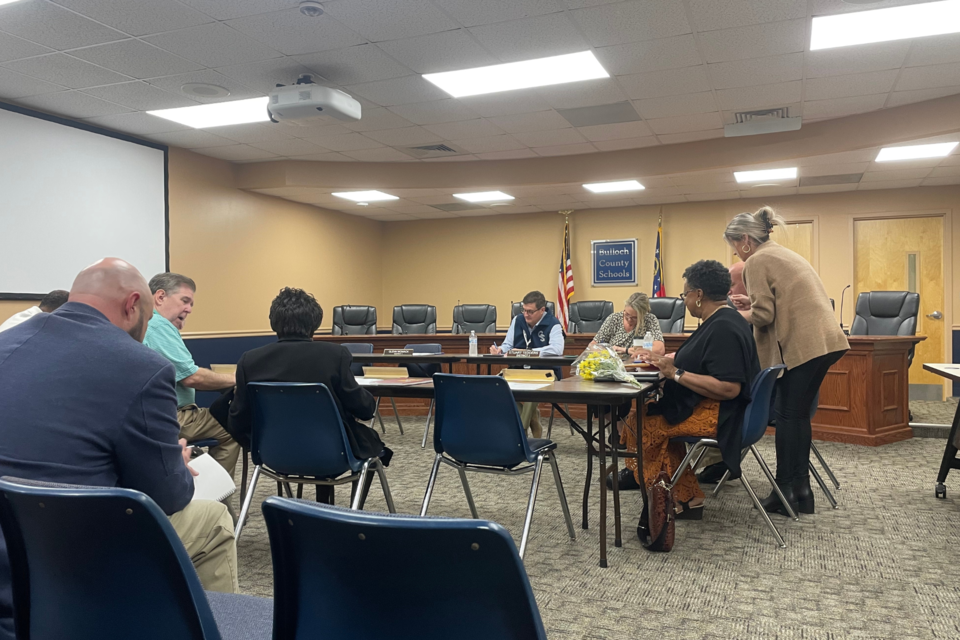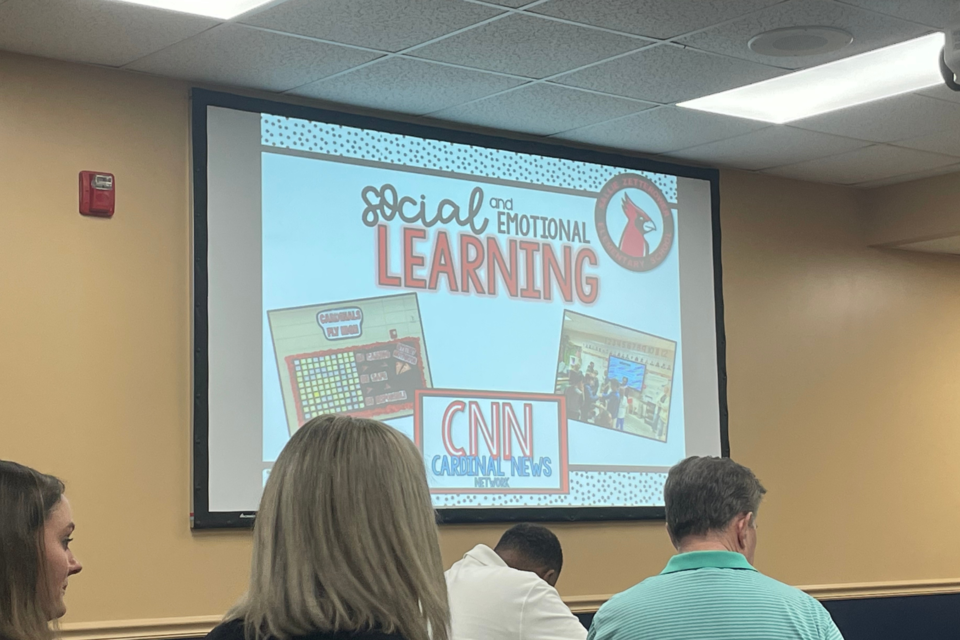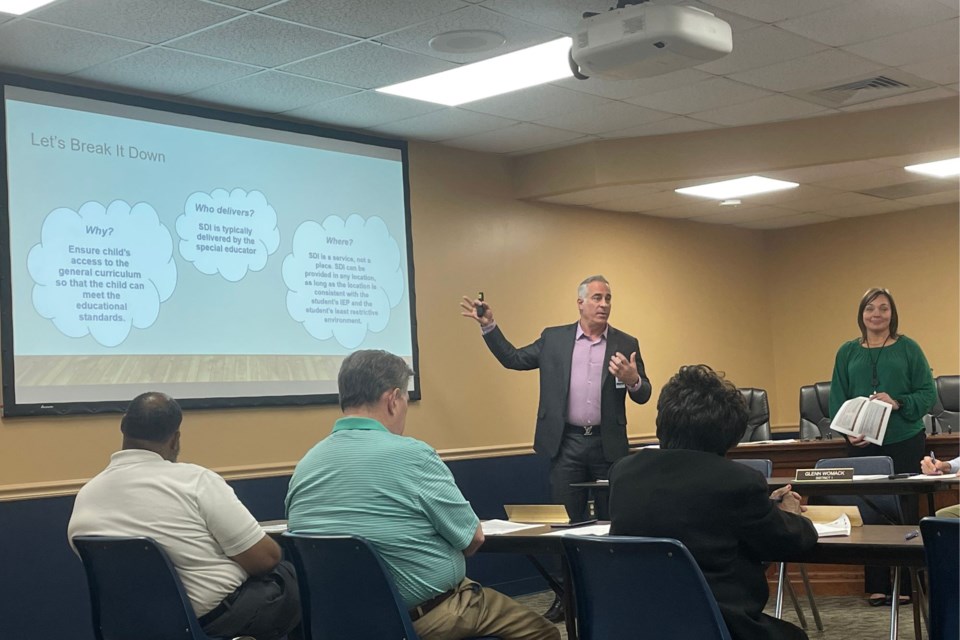The scheduled Bulloch County Board of Education work session was called to order at 6:30 p.m. on Thursday, January 25. Chairwoman Elizabeth Williams led attendees in a moment of silence and the Pledge of Allegiance.
Superintendent Charles Wilson recommended the executive session be moved to follow the work session. This amendment was approved unanimously, and the meeting moved directly into a presentation by the faculty of Sallie Zetterower Elementary School.

Work Session
1. School Spotlight: Sallie Zetterower Elementary
SZE’s mission is to Inspire every student to think, to learn, to achieve and to care. Farrah Reddick, assistant principal, talked about the success of parent involvement in activities like family literacy night, Veterans Day breakfast, holiday musicals, field day and upcoming events like STEM day. Activities like STEM day allow all children to participate in the event because it is during the day instead of after school hours.
Anna Perkins, the reading and ELA instruction coach, presented the school improvement plan. SZE used data to establish “Points of Pride” and “Problems of Practice.” With these factors identified, they determined initiatives and action steps for improving students' success with phonics and math.
One initiative, UFLI Foundation, is a phonics program that is being utilized in kindergarten classrooms, which incorporates online materials and tools. The cost for UFLI is very low with the school only paying for training and manuals.
“So far UFLI has made me a much more confident teacher,” said kindergarten teacher Katie Rushing.
Misty Anderson, the math instruction coach, presented a tool called review preview, which tasks students with up to five questions that review past content that students may have struggled with. Fact fluency is another implemented tactic, encouraging proficiency in recalling basic facts.
Second grade teacher Tiffany Robbins described how she integrates physical fitness activities into the fact fluency practice to get her students more excited, in addition to computer activities and task cards.
“I’m happy to see that our elementary schools are consistent with phonemic awareness…This will make a huge difference,” said Williams.
SZE has also increased their focus on social and emotional learning. Robbins exemplified her morning routine of playing a familiar song, gathering the students and having them share their thoughts on questions like, “What's the worst food you have ever tried?”
“They love it and it builds community in the classroom,” said Robbins.

Cardinals Fly High is a program that recognizes and rewards good behavior. The faculty at the meeting praised the program for helping teachers stay in positive mindsets rather than focusing on disciplinary actions.
Participation in the school's “Cardinal News Network” was formerly only available to 5th graders, but now it is available to other grade levels, and the faculty says it has been great for the kids.
Through CNN, children get the chance to share the weather, give lessons on respect, and connect with other students.
The presenters also highlighted the introduction of an unusually high volume of new teachers due to more vacancies. New teachers Jorjanne Drury, Linzie LaFavor and Lauren McCorkle shared their experience as “newbies” at SZE. They credited the welcoming energy and support they are receiving for their success so far.
“[The Instructional coaches]) have been right there helping us along the way,” said McCorkle, also praising her teammates' willingness to share their resources.
2. Specially Designed Instruction for Students with Disabilities at Langston Chapel Elementary School and Stilson Elementary School (Langston Chapel Middle School is still receiving this support, as well, although it was removed from TSI list).
As covered in the last meeting, there are many efforts being focused towards TSI identified schools. A part of these schools identification criteria was “Teachers struggling with scaffolding Tier 1 instruction to help students close learning gaps quickly,” according to Teresa Philllips, Assistant Superintendent for School Improvement. Additionally, struggles of the students within the disability sub-group also contributed to the placement of the schools on the TSI list. Many of the problems in the SWB sub-group are related to staffing and scheduling issues.
Specially Designed Instruction (SDI) is being implemented to adapt instruction to the unique needs of a student that result from the student’s disability, to ensure access to the general curriculum.
SDI is different from the traditional co-teaching methods between special education teachers and regular education teachers.
SDI means special instructors become experts in individual needs for students' disability and characteristics, and work with regular education instructors to help students learn curriculum through facilitation and adaptation as appropriate to the students' needs. The three elements of SDI are focusing on content, methodology and delivery of instruction.
Phillips says SDI is done by teachers and is about what the instructor can do to help the child, not what the child can do. Teachers need to be content experts and be able to cater to the needs of individual learners in collaboration with special educators.
“The planning is absolutely critical… there's a lot of moving parts,” said Jeff Tysinger, Director of Compliance and Program Evaluation. ”You have to be able to work together really well.”

The goals of SDI include:
- Building common language
- Establishing essential elements
- Identifying the “what” and” why” of SDI
- Identify five key elements of implementation fidelity
- Define and implement data based individualization framework for successful SDI
Phillips and Tysinger presented the following data:
- 63% of children with IEPs are served inside a regular education class for 80% or more of the day.
- 95% of students with IEPs spend some portion of the day in regular class.
“Students with disabilities are general education first, then we layer special education on top,” said Phillips. When asked about the impacts of teaching both types of students in one classroom, Tysinger said there is a positive correlation between the success of regular education students and the success of special education students.
Special education teachers will take steps to prepare for SDI including creating class learning plans and getting to know their students, obtaining instructional tasks from general education teachers, gathering information about the tasks and setting for the lessons and intentionally planning strategies with general education teachers for special education students to compensate for their disability so they can access the curriculum.
Langston Chapel Elementary School, Langston Chapel Middle School, and Stilson Elementary School are partnering with the Georgia Learning Resources System (GLRS) to provide training and ongoing coaching, as well as utilizing Fulton County School’s framework and rubric for SDI implementation and progress monitoring.
Some challenges that are anticipated with the implementation of SDI include the initial training and ongoing coaching, progress monitoring and identifying where additional support is needed, and the expectancy for full implementation to take multiple years.
After the presentation, the Board voted unanimously to move into executive session. After the executive session, the meeting was adjourned at 8:30 p.m.
The next Bulloch County Board of education meeting will be on Thursday, February 8, in the boardroom at the Central Office located at 150 Williams Road.



